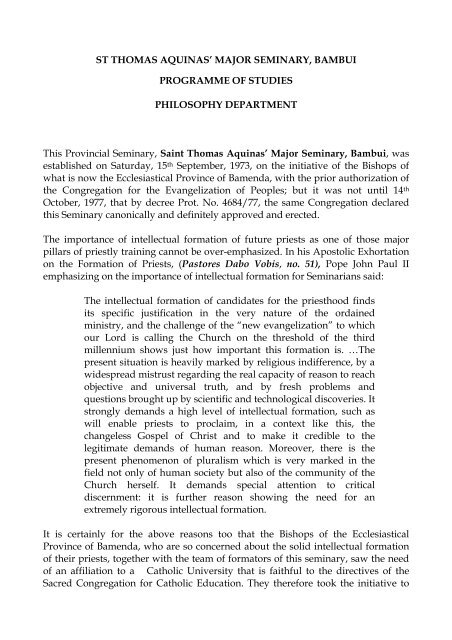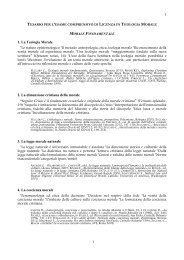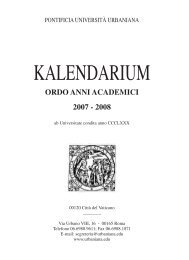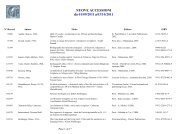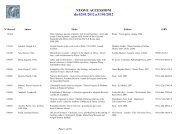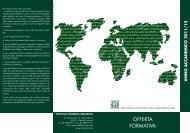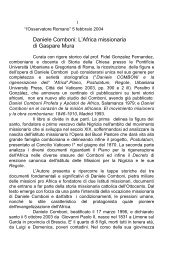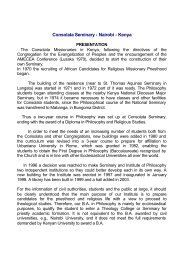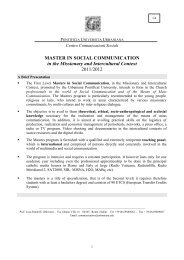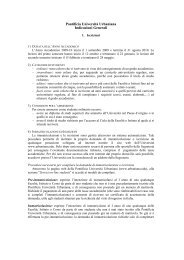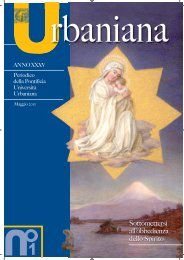Programme of studies Philosophy Department - St. Thomas Aquinas ...
Programme of studies Philosophy Department - St. Thomas Aquinas ...
Programme of studies Philosophy Department - St. Thomas Aquinas ...
You also want an ePaper? Increase the reach of your titles
YUMPU automatically turns print PDFs into web optimized ePapers that Google loves.
ST THOMAS AQUINAS’ MAJOR SEMINARY, BAMBUIPROGRAMME OF STUDIESPHILOSOPHY DEPARTMENTThis Provincial Seminary, Saint <strong>Thomas</strong> <strong>Aquinas</strong>’ Major Seminary, Bambui, wasestablished on Saturday, 15 th September, 1973, on the initiative <strong>of</strong> the Bishops <strong>of</strong>what is now the Ecclesiastical Province <strong>of</strong> Bamenda, with the prior authorization <strong>of</strong>the Congregation for the Evangelization <strong>of</strong> Peoples; but it was not until 14 thOctober, 1977, that by decree Prot. No. 4684/77, the same Congregation declaredthis Seminary canonically and definitely approved and erected.The importance <strong>of</strong> intellectual formation <strong>of</strong> future priests as one <strong>of</strong> those majorpillars <strong>of</strong> priestly training cannot be over-emphasized. In his Apostolic Exhortationon the Formation <strong>of</strong> Priests, (Pastores Dabo Vobis, no. 51), Pope John Paul IIemphasizing on the importance <strong>of</strong> intellectual formation for Seminarians said:The intellectual formation <strong>of</strong> candidates for the priesthood findsits specific justification in the very nature <strong>of</strong> the ordainedministry, and the challenge <strong>of</strong> the “new evangelization” to whichour Lord is calling the Church on the threshold <strong>of</strong> the thirdmillennium shows just how important this formation is. …Thepresent situation is heavily marked by religious indifference, by awidespread mistrust regarding the real capacity <strong>of</strong> reason to reachobjective and universal truth, and by fresh problems andquestions brought up by scientific and technological discoveries. Itstrongly demands a high level <strong>of</strong> intellectual formation, such aswill enable priests to proclaim, in a context like this, thechangeless Gospel <strong>of</strong> Christ and to make it credible to thelegitimate demands <strong>of</strong> human reason. Moreover, there is thepresent phenomenon <strong>of</strong> pluralism which is very marked in thefield not only <strong>of</strong> human society but also <strong>of</strong> the community <strong>of</strong> theChurch herself. It demands special attention to criticaldiscernment: it is further reason showing the need for anextremely rigorous intellectual formation.It is certainly for the above reasons too that the Bishops <strong>of</strong> the EcclesiasticalProvince <strong>of</strong> Bamenda, who are so concerned about the solid intellectual formation<strong>of</strong> their priests, together with the team <strong>of</strong> formators <strong>of</strong> this seminary, saw the need<strong>of</strong> an affiliation to a Catholic University that is faithful to the directives <strong>of</strong> theSacred Congregation for Catholic Education. They therefore took the initiative to
apply for an affiliation to the Pontifical Urban University, Rome, and by decree No.902/78/2 issued at Rome on December 1 st , 1978, the Congregation for CatholicEducation declared the <strong>Philosophy</strong> <strong>Department</strong> <strong>of</strong> <strong>St</strong>. <strong>Thomas</strong> <strong>Aquinas</strong>’ MajorSeminary, Bambui, to be an Affiliate <strong>of</strong> the <strong>Philosophy</strong> Faculty <strong>of</strong> the PontificalUrban University, Rome.This <strong>Programme</strong> <strong>of</strong> <strong>St</strong>udies for <strong>Philosophy</strong> <strong>Department</strong> in STAMS, has beenprepared taking into consideration the directives <strong>of</strong> the Sacred Constitutions <strong>of</strong> theSecond Vatican Council on The Decree on the Training <strong>of</strong> Priests (OptatamTotius,no. 14-15) which states that:In the revision <strong>of</strong> ecclesiastical <strong>studies</strong> the main object to be kept inmind is a more effective coordination <strong>of</strong> philosophy and theology sothat they supplement one another in revealing to the minds <strong>of</strong> thestudents with ever increasing clarity the Mystery <strong>of</strong> Christ, whichaffects the whole course <strong>of</strong> human history, exercises an unceasinginfluence on the Church, and operates mainly through the ministry <strong>of</strong>the priest.Philosophical subjects should be taught in such a way as to lead thestudents gradually to a solid and consistent knowledge <strong>of</strong> man, theworld and God. The students should rely on that philosophicalpatrimony which is forever valid, but should also take account <strong>of</strong>modern philosophical <strong>studies</strong>, especially those which have greaterinfluence in their own country, as well as recent progress in thesciences. Thus, by correctly understanding the modern mind, studentswill be prepared to enter into dialogue with theircontemporaries…while being able to detect and refute those that arefalse.It is in the light <strong>of</strong> what The Decree on the Training <strong>of</strong> Priests (O.T.) says above andwith the awareness that the study <strong>of</strong> philosophy as a crucial stage <strong>of</strong> the intellectualformation <strong>of</strong> future priests that our Seminary tries as much as possible to have thestudents well grounded in philosophy so as to better prepare their minds fortheological <strong>studies</strong> and to deepen their understanding and interpretation <strong>of</strong> theperson, and <strong>of</strong> the person’s freedom and relationships with the world and withGod, and also to enrich their intellectual formation in the “cult <strong>of</strong> truth”.(Cf.Pastores Dabo Vobis, no 52).It is our ardent hope that the team <strong>of</strong> formators and the Seminarians <strong>of</strong> STAMS willfind this revised <strong>Programme</strong> <strong>of</strong> <strong>St</strong>udies for <strong>Philosophy</strong> useful.STAGES AND METHOD OF INTELLECTUAL FORMATION.
There are two major stages in the seminarian’s intellectual formation.During the first three years the teaching <strong>of</strong> philosophy and its kindreddisciplines is the focus <strong>of</strong> attention.The last four years are taken up by the theology and its related sciences.Being present during lectures, and personal research are the main methodsthe seminarian shall avail himself <strong>of</strong> in the course <strong>of</strong> his formation. He may notabsent himself from lectures without the knowledge <strong>of</strong> his class co-ordinator, whowill, in turn, inform the pr<strong>of</strong>essors concern. The seminarian will be required toacquire for himself a copy <strong>of</strong> the <strong>Programme</strong> <strong>of</strong> <strong>St</strong>udies.Research takes two forms. The seminarian is required to make research forseminar papers and at the end <strong>of</strong> each <strong>of</strong> the two major stages, write a dissertation<strong>of</strong> not more than 40 typed pages. The Seminary Library is at the disposal <strong>of</strong> theseminarian in this regard. He shall maintain silence whenever he is in the Libraryand treat the books and magazines therein with due consideration for posterity.The school year is divided into two semesters. At the end <strong>of</strong> every semester,the seminarian shall present himself for examinations. There shall be two sessions:January and June. 60% is the pass mark in any given subject. There will be sessionsin February and October for referred candidates <strong>of</strong> the January and June sessionsrespectively. A candidate who scores less than 40% at both the Ordinary andreferred sessions shall be advised to withdraw.At the end <strong>of</strong> each major stage <strong>of</strong> intellectual formation, the candidate shallbe required to write the B. Phil., B.D., or Diploma examinations. A student whoscores less than 60% in the February/October sessions automatically qualifies forthe Diploma. Entry conditions are to be found elsewhere in this <strong>Programme</strong> <strong>of</strong><strong>St</strong>udies. Candidates who qualify for, write and are successful in the degreeexaminations will be awarded certificates by the Pontifical Urban University,Rome, to which the Seminary is affiliated.1. GENERAL ORIENTATION1.1. AIMThe department aims at promoting a comprehensive study <strong>of</strong> philosophywith a view to having the student acquaint himself with the general philosophicalculture but paying particular attention to the systematic philosophy <strong>of</strong> theAristotelico-Thomistic tradition and the history <strong>of</strong> philosophy in general.1.2. ENTRY REQUIREMENTS1.2.1. The candidate shall have completed at least the curriculum <strong>of</strong> <strong>studies</strong> andobtained the certificates and credits required in Cameroon as a condition foradmission into a duly approved university;
1.2.2. A pass in the English and French Languages at the Ordinary Level andReligious Knowledge at the Advanced Level in the General Certificate <strong>of</strong> Educationor its equivalent.1.3. INTERNAL DEPARTMENTAL EXAMINATIONS:The academic year is divided into two semesters. At the end <strong>of</strong> everysemester, the student shall present himself for examinations. There shall be twosessions: January and June. 60% is the pass mark in any given subject. There will besessions in February and October for referred candidates <strong>of</strong> the January and Junesessions respectively.1.4. DEGREE EXAMINATIONS:The <strong>Department</strong> <strong>of</strong> <strong>Philosophy</strong> <strong>of</strong> this institution is affiliated to the Faculty <strong>of</strong><strong>Philosophy</strong> <strong>of</strong> the Pontifical Urban University in Rome. At the end <strong>of</strong> hisphilosophical <strong>studies</strong>, each student is required to sit for a Bachelor <strong>of</strong> <strong>Philosophy</strong>Examination or a Diploma <strong>of</strong> <strong>Philosophy</strong> Examination. To qualify for theseExaminations the following conditions are necessary:a) Research work in <strong>Philosophy</strong> presented in the form <strong>of</strong> adissertation <strong>of</strong> not more than 40 typed pages:b) An average mark <strong>of</strong> 60% or above in all the Main Courses <strong>of</strong>fered inphilosophy for those going in for the B.Phil. or between 40% - 60% forthose going in for the Diploma in <strong>Philosophy</strong>.c) A successful defence before a panel <strong>of</strong> three pr<strong>of</strong>essors, <strong>of</strong> thedissertation presented by the candidate;d) A comprehensive written examination in all the Main Courses <strong>of</strong>feredin <strong>Philosophy</strong>. To obtain a pass, the candidate must score 60% andabove, in all the sections <strong>of</strong> <strong>Philosophy</strong> he is examined on.e) All the scripts and results <strong>of</strong> the written examination as well as thedefence results are sent to the Urban University for validation.1.5. THE DEPARTMENTAL ACADEMIC STAFF:The <strong>Philosophy</strong> <strong>Department</strong> is staffed in accordance with the requirements <strong>of</strong>a higher institute <strong>of</strong> ecclesiastical <strong>studies</strong>. It is the responsibility <strong>of</strong> the Bishops <strong>of</strong>the Ecclesiastical Province <strong>of</strong> Bamenda to provide the academic staff. Sincemembers <strong>of</strong> staff may be changed, a list containing the names and qualifications <strong>of</strong>faculty shall be made available to all interested at the beginning <strong>of</strong> each academicyear.(Inserire in formato pdf)2. COURSES2.1. MAIN COURSESPM 100 – African <strong>Philosophy</strong>(Afr.Phil)
PM 101 – African Traditional Religion (ATR)PM 102 – Cosmology(Cosmo)PM 103 – Epistemology(Epist)PM 104 – Ethics(Ethics)PM 105 – History <strong>of</strong> Ancient <strong>Philosophy</strong> (Anc.Phil)PM 106 – History <strong>of</strong> Medieval <strong>Philosophy</strong> (Med.Phil)PM 107 – History <strong>of</strong> Modern <strong>Philosophy</strong> (Mod.Phil)PM 108 – History <strong>of</strong> Contemporary <strong>Philosophy</strong> (Con.Phil)PM 109 – Introduction to <strong>Philosophy</strong>(Int.Phil)PM 110 – Logic(Logic)PM 111 – Metaphysics(Metaph)PM 112 – Modern Psychology(Mod.Psy)PM 113 – Philosophical Anthropology(Phil.Ant)PM 114 – <strong>Philosophy</strong> <strong>of</strong> Religion(Phil.Rel)PM 115 – Political <strong>Philosophy</strong>(Pol.Phil)PM 116 – Science and Religion(Sci&Rel)PM 117 – Scientific Methodology(Method)PM 118 – Social Anthropology(Soc.Anth)PM 119 – Theodicy(Theod)2.2. SEMINARSPM 120 – Ethics SeminarPM 121 – History <strong>of</strong> Contemporary <strong>Philosophy</strong> SeminarPM 122 – Metaphysics Seminar2.3. SUBSIDIARY COURSESPS 200 – Introduction to ScripturePS 201 – History <strong>of</strong> IsraelPS 202 – Introduction to SpiritualityPS 203 – ScripturePS 204 – Mystery <strong>of</strong> ChristPS 205 – EnglishPS 206 – FrenchPS 207 – GreekPS 208 – LatinPS 209 – Calligraphy(SS)(SS)(Spirit)(SS)(Myst.Xt)(Eng)(Fren)(Greek)(Latin)(Callig)3. CLASS DISTRIBUTION OF COURSES3.1. PHILOSOPHY ONEPM 105 – History <strong>of</strong> Ancient <strong>Philosophy</strong> (Sem. I) 1PM 106 – History <strong>of</strong> Medieval <strong>Philosophy</strong> (Sem. II) 21 (Sem. I) stands for the First Semester.
PM 110 – Logic (Sem. I & II)PM 109 – Introduction to <strong>Philosophy</strong> (Sem. I)PM 117 – Scientific Methodology (Sem. I & II)PS 200 – History <strong>of</strong> Israel (Sem. I & II)PS 202 – Introduction to Spirituality (Sem. I & II)PS 204 – Mystery <strong>of</strong> Christ (Sem. I & II)PS 205 – English (Sem. I & II)PS 206 – French (Sem. I & II)PS 207 – Greek (Sem. I & II)PS 208 – Latin (Sem. I & II)PS 209 – Calligraphy (Sem. I & II)3.2. PHILOSOPHY TWOPM 103 – Epistemology (Sem. II)PM 104 – Ethics (Sem. I & II)PM 107 – History <strong>of</strong> Modern <strong>Philosophy</strong> (Sem. I & II)PM 111 – Metaphysics (Sem. I)PM 113 – Philosophical Anthropology (Sem. II)PM 115 – Political <strong>Philosophy</strong> (Sem. II)PM 102 – Cosmology (Sem. I)PM 120 – Ethics Seminar (Sem. I)PM 122 – Metaphysics Seminar (Sem. II)PS 201 – History <strong>of</strong> Israel (Sem. I & II)PS 202 – Introduction to Spirituality (Sem. I & II)PS 205 – English (Sem. I & II)PS 206 – French (Sem. I & II)PS 207 – Greek (Sem. I & II)PS 208 – Latin (Sem. I & II)PS 209 – Calligraphy (Sem. I & II)3.3. PHILOSOPHY THREEPM 100 – African <strong>Philosophy</strong> (Sem. I)PM 101 – African Traditional Religion (Sem. II)PM 108 – History <strong>of</strong> Contemporary <strong>Philosophy</strong> (Sem. I)PM 119 – Theodicy (Sem. I)PM 112 – Modern Psychology (Sem. II)PM 114 – <strong>Philosophy</strong> <strong>of</strong> Religion (Sem. I)PM 116 – Science and Religion (Sem. II)PM 118 – Social Anthropology (Sem. I)2 (Sem. II) stands for the Second Semester.
4. Plato: Sources <strong>of</strong> Plato’s philosophy: Socrates, Pythagoras and thePythagoreans; Heraclitus and Parmenides. Dialogues and the Academy; theTheory <strong>of</strong> Ideas, the Nature <strong>of</strong> the Soul; Sources <strong>of</strong> Evil; the Theory <strong>of</strong>Knowledge in the Meno, Phaedo and Republic. Justice and Happiness inthe Republic. Plato’s Physics, Forms <strong>of</strong> Government and Letter VII.5. Aristotle: Life and Works, Relationship to Plato; Experience, Art andKnowledge; Change and its Explanation and the First Mover [Physics I-III& VIII]. Living bodies and the Body and Soul [De Anima II]. The Objectand Method <strong>of</strong> Ethical Science [Nicomachean Ethics I]. The Project <strong>of</strong> aMetaphysical Science [Metaphysics I, II, IV & VI]. Happiness in theNicomachean Ethics X. Moral Excellence [Nicomechean Ethics II].Intellectual Virtues and Happiness (Nicomachean Ethics VI). The ImmobileSubstance (Metaphysics XII).6. Hellenism: Historical background; New Movements in <strong>Philosophy</strong>:Epicureanism, <strong>St</strong>oicism and Scepticism: their interaction and popularappeal.7. Plotinus and Neoplatonism: The Platonic tradition; Plotinus: thegeneration <strong>of</strong> the world in the Enneads. Matter and Evil in Plotinus. Paganand Christian Neoplatonism.Bibliography:Along with the relevant primary sources, see also:Armstrong, A. H., An Introduction to Ancient <strong>Philosophy</strong>, (London, 1957); ________.,(ed.), The Cambridge History <strong>of</strong> Later Greek and Early Medieval <strong>Philosophy</strong>, (Cambridge,1967); Barnes, J., The Toils <strong>of</strong> Scepticism, (Cambridge, 1990); Composta, D., History <strong>of</strong>Ancient <strong>Philosophy</strong>, (Rome, 1990); Conford, F. M., Before and After Socrates (London,1976); Copleston, F., History <strong>of</strong> <strong>Philosophy</strong>, Vol. I, (London, 1976); Guthrie, W. K. C.,A History <strong>of</strong> Ancient <strong>Philosophy</strong>, Vol. I (Cambridge, 1971); Long, A. A.,Hellenistic <strong>Philosophy</strong>, (London, 1974); O’Meara, D. J., Plotinus: An Introduction to theEnneads (Oxford, 1993); Rist, J. M., Plotinus: The Road to Reality, (Cambridge, 1967);<strong>St</strong>ace, W. T., A Critical History <strong>of</strong> Greek <strong>Philosophy</strong>, (London, 1962); YARZA, I.,History <strong>of</strong> Ancient <strong>Philosophy</strong>, Signa-Tala Publishers, Inc., Manila. 1994.PM 106 – History <strong>of</strong> Medieval <strong>Philosophy</strong> (Sem. II)1. Greek <strong>Philosophy</strong> and Christianity: First encounters and earliest attitudes:the Apologists, Clement <strong>of</strong> Alexandria, Tertullian, Neoplatonism andOrigen.2. <strong>St</strong>. Augustine: His development: African-Roman setting; Manichaeism,Scepticism, Neoplatonism and Christianity. The soul’s search for God: Faithseeking understanding, grace and truth; seeking happiness and truthand finding God. Faith, authority and reason. Free will and sin: The City <strong>of</strong>God.
3. Neoplatonism after Augustine: Boethius: Plato and Aristotle translations,Porphyry’s Isagoge. Pseudo-Dionysius and John Scotus Erigena.4. Historical Background to Scholasticiam: Thee Carolingian Renaissance,Monastic and Cathedral Schools, the making <strong>of</strong> Scholasticism, revival <strong>of</strong>Dialectic.5. <strong>St</strong>. Anselm: Positive and fruitful development <strong>of</strong> dialectic in the service <strong>of</strong>the Augustinian tradition in theology. Example: the ontological argument,(Proslogion 1-4).6. Peter Abelard: The debate about universals. Controversy concerning hisapplication <strong>of</strong> Dialectic to theology: opposition <strong>of</strong> <strong>St</strong>. Bernard. Continuingdevelopment toward systematizing theology: Peter Lombard’s Sentences;the growth <strong>of</strong> universities.7. Aristotle re-discovered: The Islamic connection. Importance <strong>of</strong> Alfarabi,Avicenna, Averroes and Maimonides. The impact <strong>of</strong> new texts on theyoung universities, especially Paris. Attitude <strong>of</strong> the Church.8. <strong>St</strong>. Bonaventure: Attitude to the new Aristotelianism. Further development<strong>of</strong> an Augustinian synthesis; soul’s journey to God; exemplarism;ontological argument.9. <strong>St</strong>. <strong>Thomas</strong> <strong>Aquinas</strong>: The development <strong>of</strong> Christian Aristotelianism. Thescope <strong>of</strong> natural reason vis-à-vis faith; knowledge <strong>of</strong> God, that He is andwhat He is. His response to the challenge <strong>of</strong> Averroism. The oppositionconfuses Siger’s Averroism and the Aristotelianism <strong>of</strong> <strong>Aquinas</strong>:Condemnations <strong>of</strong> 1270 and 1277.10. Subsequent developments: Disengagement <strong>of</strong> faith and reason; initiatedby Duns Scotus, extreme development in the Via Moderna by Ockhamand Nominalists Movement.11. Renaissance Philosophies: Nicholas <strong>of</strong> Cusa. New turns to Plato andAristotle.Bibliography:Chervin, R., et al., Love <strong>of</strong> Wisdom, Ignatius Press, San Francisco, 1988; Copleston,F., History <strong>of</strong> <strong>Philosophy</strong>, Vols. II & III, Search Press, Ltd., London, 1974; Gilson, E.,History <strong>of</strong> Christian <strong>Philosophy</strong> in the Middle Ages, Sheed & Ward, London, 1955;Knowles, D., The Evolution <strong>of</strong> Medieval Thought, 2 nd ed., Longman Group, U.K.,1988; Leff, G., Medieval Thought, Pelican books, 1958; Mclnemy R.M., (ed.), NewThemes in Chistian <strong>Philosophy</strong>, University <strong>of</strong> Notre Dame Press, Indiana, 1968;Mondin, B., A History <strong>of</strong> Medieval <strong>Philosophy</strong>, tr. by Myroslaw A. Cizdyn,Urbaniana University Press, Rome, 1991; Pegis, A. C.,The Middle Ages and<strong>Philosophy</strong>, Henry Regney Company, Chicago, 1963; YARZA, I., History <strong>of</strong> Medieval<strong>Philosophy</strong>, Signa-Tala Publishers, Inc., Manila. 1996.PM 110 - Logic (Sem I & II)1. Introduction: Logic as a Science: Spontaneous Logic; the art <strong>of</strong> Logic; thescience <strong>of</strong> Logic; the sefulness <strong>of</strong> Logic. Logic and other philosophical
disciplines: Logic and psychology; Logic and gnoseology; Logic andMetaphysics. Brief historical survey.2. The operations <strong>of</strong> the mind: The mind; fundamental operations <strong>of</strong> themind; the grasp <strong>of</strong> knowledge.3. The uses <strong>of</strong> Language.4. Ideas and terms: The idea; the expression <strong>of</strong> ideas; the clarification <strong>of</strong>ideas; definitions.5. Judgements and propositions: The judgement; the proposition; properties<strong>of</strong> propositions.6. Reasoning and argument:Reasoning; expression and logical reasoning; the laws <strong>of</strong> argument; thecategorical syllogism and its eight laws; the figure <strong>of</strong> the categoricalsyllogism; moods <strong>of</strong> the categorical syllogism; establishing the validity <strong>of</strong> acategorical syllogism; establishing the validity <strong>of</strong> a categorical syllogism byreduction <strong>of</strong> the first figure.7. The Hypothetical Syllogism: the conditional syllogism; the conjunctivesyllogism; the disjunctive syllogism. Other forms <strong>of</strong> syllogistic arguments:the enthymeme; the epicherema; the polysyllogism; sorites; the dilemna.8. Laws <strong>of</strong> thought.9. Fallacies.10. Symbolic Logic.Bibliography:Aprangler, M. M., Logic: An Aristotelian Approach, University Press <strong>of</strong> America,1986; Copi, I. M., Introduction to Logic, Collier-MacMillan Co., London, SeventhEdition, 1986; Ennis, R. H., Ordinary Logic, Prentice-Hall Inc., New Jersey, 1969;Lemmon, E. J., Beginning Logic, <strong>Thomas</strong> Nelson and Sons, London, 1965; Mitchell,D., An Introduction to Logic, Hutchinson & Co., London, 1967; Toulmin, S. E., TheUses <strong>of</strong> Argument, University Press, Cambridge, 1969.PM 117 – Scientific Methodology (Sem I & II)1. What is Methodology?2. Its usefulness.3. <strong>St</strong>udy: Aim at personal work in study. Dispositions for effective <strong>studies</strong>.Conditions for effective <strong>studies</strong>.4. Classes or lectures: Their usefulness. Limitations and dangers <strong>of</strong> classes.Conditions for effective classes.5. Scientific work proper: Sources and subsidiary works. Dispositions forscientific work; taking notes. Examples <strong>of</strong> scientific works: Term papers,Seminars, Dissertations and Theses. Choice <strong>of</strong> subjects. Basic tools forscientific work.6. Introduction to the use <strong>of</strong> the Library and different arrangements in aLibrary.
Bibliography:Albaugh, R. M., Thesis Writing: A Guide to Scholarly <strong>St</strong>yle, Littlefield, Adams andCo., Totowa, N.J. 1968; Alexis, A. J., Methodology for Research: Guide for WritingDissertations, Theses and Scientific Papers, Bangalore, 1986; Fr. Dominic <strong>of</strong> <strong>St</strong>. Teresa,O.C.D., Methodology <strong>of</strong> <strong>St</strong>udy and Scientific Work, 2 nd ed., Alwaye-3, India, 1965;Meynet, R., Norme Tipografiche per la Composizione dei Testi con il Computer, EditricePontificia Università Gregoriana, Roma, 2000;Henrici, P., Guida Pratica Allo <strong>St</strong>udio, Editrice Pontificia Università Gregoriana,Roma, 1997.PS 200 – Introduction to Scripture (Sem. 1 & II)This is an introductory course in Sacred Scripture; however, it is presumedthat at this stage the Seminarians already have a good knowledge <strong>of</strong> what theBible is, with regard to authorship, inspiration, canon, divisions. A quickrevision could be done, but the main thrust will be to introduce them to thevarious traditions behind the Old Testament writings and to enable them cometo grips with how and when the New Testament was composed and written.1. The Bible.2. The Books <strong>of</strong> the Bible.3. How to read the Bible.4. The Bible – the Word <strong>of</strong> God.5. The Old Testament analysed (Sources – (L), J, E, P, D, (B, H)).6. Inspiration.7. The Biblical Canon.8. Hermeneutics.In the second semester, the Seminarians will be introduced specifically to theBook <strong>of</strong> the Psalms as the prayer book <strong>of</strong> God’s people, then and now. Thevarious types <strong>of</strong> psalms will be studied together with the life situations thatoccasioned them. Selected psalms will be read as part <strong>of</strong> the course.1. Introduction.2. Numbering the Psalms.3. Division <strong>of</strong> the Psalter.4. The Psalter – A Prayer Book.5. Psalm Types.6. Christ in the Psalms.7. General Survey <strong>of</strong> the Psalter.8. Explanation <strong>of</strong> selected Psalms.Bibliography - Main Texts:Childs, B. S., Introduction to the Old Testament as Scripture, London: SCM Press, 3 rdImpr., 1987; Harrington, W. J., Key to the Bible, 3 vols., Makati, Philippines: 1987;
Jaki, S. I., Praying the Psalms (A Commentary), Grand Rapids: William B. EerdmansPublishing Company, 2001; <strong>St</strong>uhlmueller, C., Psalms, 2 vols., Wilmington,Delaware: Michael Glazier, Inc., 1983.Complementary Books:Anderson, A. A., Psalms, 2 Vols., in The New Century Bible-Commentary, GrandRapids, Michigan: W.M.B. Eerdmans, 1981; Westermann, C., The Psalms,Minneapolis: Augsburg Pub. House, 1980.PS 202 – Introduction to Spirituality (Sem I & II)1. Spirituality: Notion. The nature and importance <strong>of</strong> Spirituality.Spirituality and Christianity. Spirituality and Religion.1. Prayer, Meditation/Mental Prayer: Notion and Origin <strong>of</strong> Meditation.Meditation in the Old Testament: Ps. 103; Gen. 24:63; etc. Meditation in theNew Testament: Mk. 10; Rom. 8:26; etc. Obstacles beginners may encounterin the practice <strong>of</strong> meditation or mental prayer.2. Some Spiritual Masters and Meditation.3. Some Methods <strong>of</strong> Meditation: <strong>St</strong>. Ignatius <strong>of</strong> Loyola, <strong>St</strong>. Francis <strong>of</strong> Sales,<strong>St</strong>. Sulpice, <strong>St</strong>. Peter <strong>of</strong> Alcantara, etc.4. The Goal <strong>of</strong> Meditation.5. The Effects <strong>of</strong> meditation.Bibliography:Bloom, A., Meditations: A Journey Through the Parables, Dimension Books, NewJersey 1972; Bloom, A., Meditations On A Theme, Mowbrays, London, 1973; Merton,A., Spiritual Direction and Meditation, The Liturgical Press, Collegeville, 1960;Rohrbach, P. T., O.C.D., Conversation with Christ, Ge<strong>of</strong>frey Chapman, London,1966; Tilman, K., The Practice <strong>of</strong> Meditation, Search Press, London, 1977.PS 204 – The Mystery <strong>of</strong> Christ (Sem I & II)1. Introduction: The Mystery <strong>of</strong> Jesus Christ; different approaches to themystery <strong>of</strong> Christ.2. The historical Jesus and biblical research. The quest <strong>of</strong> the historical Jesus;an emerging consensus within biblical research.3. Rediscovering the historical Jesus. An historical minimum in the life <strong>of</strong>Jesus; the closing stages in the life <strong>of</strong> Jesus.4. The resurrection: a survey <strong>of</strong> the evidence. The Pauline evidence; theevangelists; what really happened?5. The mystery <strong>of</strong> the resurrection: a theological response. The biblicalbackground to the resurrection; the overall impact <strong>of</strong> the resurrectionexperience; different christological responses to the Easter Event.
Bibliography:Galot, J., Who is Christ? A Theology <strong>of</strong> the Incarnation, Gregorian University Press,Rome, 1980; Kasper, W., Jesus the Christ, Burns and Oates, London, 1976; Lane, D.A., The Reality <strong>of</strong> Jesus, An Essay in Christology, Veritas Publications, Dublin, 1975;John Paul II, Redemptor Hominis, Typis Polyglottis Vaticanis, Roma, 1979;O’Collins, G., Interpreting Jesus, Paulist Press, Ramsey, 1983.PS 205 – English (Sem I & II)The Basics <strong>of</strong> Traditional Grammara. PARTS OF SPEECH1. Verbs2. Nouns3. The Adjective3.1. Kinds <strong>of</strong> Objectives3.2. Comparison <strong>of</strong> Adjectives4. Adverbs4.1. Kinds <strong>of</strong> Adverbs4.2. Comparison <strong>of</strong> Adverbs5. Pronouns5.1. Definition and Identification <strong>of</strong> pronouns and their antecedents.5.2. Classification <strong>of</strong> Pronouns6. Prepositions7. Conjunctions8. Interjections.b. ENGLISH TENSES1. Classification <strong>of</strong> tenses2. The Continuous Tenses3. The Perfect Tenses4. The Perfect Continuous Tenses5. Other Tensesc. SENTENCE STRUCTURE1. The Sentence2. Classification <strong>of</strong> Sentences2.1. Classification by Type2.2. Classification by <strong>St</strong>ructured. Clause Analysise. Phrasesf. Basic Sentence Faultsg. Faulty Agreementh. Active/Passive Voicei. Participlesj. The Paragraph
Bibliography:Allen A. <strong>St</strong>annard, Living English <strong>St</strong>ructure, Essex: Longman, 1974, Crystal, D., TheEnglish Language, London: Penguin, 1988; Etherton, A. R. B., Mastering ModernEnglish, Essex: Longman, 1986; Greenbaum, S. and Quirk, R., A <strong>St</strong>udent’s Grammar<strong>of</strong> English Language, Essex: Longman, 1990; Greenbaum, S., An Introduction toEnglish Grammar, Essex: London, 1991; Hewings, M., Advanced Grammar in Use,Cambridge: CUP, 1999; Hilton, C. and Hyder, M., Punctuation and Grammar,London: <strong>St</strong>aples Printers, 1993; Ndongmanji, J. N., Effective Communication inEnglish: A Review <strong>of</strong> Traditional Grammar and the Problem Areas <strong>of</strong> Non-native Speakers,Limbe: Vision Educational Publications, 2005; Palmer, F., Grammar,Harmondsworth: Penguin, 1992; Pryse, B. E., English Without Tears, Glasgow:Collins, 1984.PS 206 – French (Sem. I & II)Objectif:Donner aux séminaristes les moyens de communiquer naturellement dansdes situations quotidiennes en relation avec une publique francophone. Leurfournir des structures de base de la langue française et des exemples del’utilisation de ces structures dans la vie de tous les jours.L’accent est mis sur la prononciation, sur les structures de base visant lacompréhension d’un passage en français préparant ainsi les séminaristes à unetechnique de synthèse si nécessaire aux prêches des sermons. Au niveau peuavancé: les tournures et les connaissances qui permettent aux séminaristesapprenants une plus grande variété stylistique.Bibliographie:Mauger, G., Cours de langue et de civilisation françaises: Hachette & Didier;Guberina, P., et Rivenc, P., Voix et images de France: Hachette & Didier; Bulger, A.,French With Ease: Assimil S.A; Whitmarsh, A Simpler French Course: LongmanGroup Limited.PS 207 – Greek (Sem. I & II)The purpose <strong>of</strong> the New Testament Greek Course is to introduce theSeminarians to the Greek Language as it is used in the New Testament, with aview to:1. Mastery <strong>of</strong> the basic morphology <strong>of</strong> NT Greek.2. Command <strong>of</strong> a fundamental vocabulary.3. Ability to translate simple exercises from Greek into Englishand from English into Greek.4. Facility in reading Greek out loud.Bibliography:
Wenham J.W., The Elements <strong>of</strong> New Testament Greek, Cambridge University Press,1965. Reprinted with corrections, 1993; Aland, K., et al., eds., The Greek NewTestament, 3 rd Edition, United Bible Societies, 1975; Swetnam J., An Introduction tothe <strong>St</strong>udy <strong>of</strong> New Testament Greek. Part One: Morphology, Editrice Pontificio IstitutoBiblico, 1992.PS 208 – Latin (Sem. I & II)Group I1. The Five Declensions.2. The Four Conjugations <strong>of</strong> the Verb: Moods; Tenses; Voices.3. Deponent and Irregular Verbs; Impersonal Verbs.4. Adjectives: The two groups.5. Pronouns: Personal; Relative; Demonstrative.6. The Comparison <strong>of</strong> Adjectives and Adverbs.7. The Ablative Absolute.8. Indirect Discourse.Group II1. The Passive voice.2. Adverbs.3. The Gerund.4. Conjunctions: Quia, quod, quoniam; dum; donec; quoad; antequam,priusquam.5. The Subjunctive in various usages.6. Some Prepositions.7. The Enclitic.8. Numerals.9. Verbs expressing various Dispositions.Group IIIThe translation <strong>of</strong> the texts indicated below.Bibliography:R. D. Wormald, R. D., Longmans’ Latin Course: Grammar and Exercises, Part 1 & II,New Edition, University Press, Aberdeen, Great Britain, 1964.Group III Latin Text for Translations:Codex Iuris Canonici, Libreria Editrice Vaticana, Roma, 1983 (Canons on theEucharist and the other Sacraments; <strong>Aquinas</strong>, T., Summa Theologiae, 1, q. 1-10,trans., McDermott, T., Blackfriars, London, 1964.PS 209 – Calligraphy (Sem. I & II)The aim <strong>of</strong> the course is corrective: to render legible the handwriting <strong>of</strong>students whose handwriting poses problems to readers. General principles <strong>of</strong>what constitutes good handwriting are given. Particular attention is paid to eachstudent depending on the level <strong>of</strong> illegibility <strong>of</strong> the handwriting.
4.2. PHILOSOPHY TWOPM 103 –Epistemology (Sem. II)1. Introduction: The Question <strong>of</strong> the Extent and Reliability <strong>of</strong> HumanKnowledge. The Question <strong>of</strong> the Possibility and Method <strong>of</strong>achieving Truth and Certitude.2. The Nature and Method <strong>of</strong> the Critical Problem. Object <strong>of</strong> the Problem.Method <strong>of</strong> the Critical Question.3. Truth and Certitude: The Nature <strong>of</strong> Truth. <strong>St</strong>ates <strong>of</strong> the Mind with Respectto Truth: Ignorance, Doubt, Suspicion, Opinion, Certitude, Error.4. Various Doctrines <strong>of</strong> Certitude and the History <strong>of</strong> the Critical Problem:Skepticism, Idealism, Sensism, Traditionalism, Dogmatism, Error.5. The Sources <strong>of</strong> Certitude: Evidence <strong>of</strong> the Senses, Evidence <strong>of</strong> the Mind,Authority.6. Scientific Certitude and its Acquisition: Science, Method, Induction.Bibliography:Llano, A., Gnoseology, trans., David L. Sands, Manila: Sinag-Tala Publishers, 2001;Gardeil, H. D., Introduction to the <strong>Philosophy</strong> <strong>of</strong> <strong>St</strong>. <strong>Thomas</strong> <strong>Aquinas</strong>. IV. Metaphysics,trans., John A. Otto, London: B. Herder Book Co., 1967; Sanguineti, J. J., Logic andGnoseology, trans., Myroslaw A. Cizdyn, Bangalore: Theological Publications inIndia, 1987; <strong>St</strong>eenberghen, F. V., Epistemology, trans., Lawrence Moonan, Louvain:Publications Universitaires, 1970.PM 104 – Ethics (Sem. I & II)1. The Nature <strong>of</strong> Ethics: definition, method, scope, division, postulates. Ethicsand other moral sciences. Types <strong>of</strong> Ethics: absolute, relative, subjective,naturalistic etc.2. Human Acts and Moral Responsibility. The Human act. Psychologicalbackground. Voluntary Acts. Free will and determinism. Levels <strong>of</strong> willingand not willing. Modifiers <strong>of</strong> responsibility. Responsibility for the acts <strong>of</strong>others.3. Conscience and Moral Goodness. The development <strong>of</strong> morality. Morality atthe level <strong>of</strong> instinct, custom, and conscience. Comparison <strong>of</strong> Morality at thelevel <strong>of</strong> custom and the level <strong>of</strong> conscience: Historical development <strong>of</strong>Conscience. The meaning <strong>of</strong> Conscience. Kinds <strong>of</strong> conscience. Theories andformation <strong>of</strong> conscience. Nature <strong>of</strong> the Moral Judgement.Moral Goodness. Ontological, Physical and Moral Good. The problem <strong>of</strong>defining moral good. Good as end, ought and value. The moral Ideal. Thenaturalistic fallacy.
4. Human Act morally considered. Morality. Rules <strong>of</strong> morals. Moral species.Moral determinants. Situation Ethics.5. Ethical Theory and Ethical <strong>St</strong>andards. The development <strong>of</strong> Ethical theory:Greek, Medieval and Modern Ethics.Classification <strong>of</strong> theories <strong>of</strong> Moral <strong>St</strong>andards.Ethical <strong>St</strong>andards. The standard as given by intuition: Types <strong>of</strong> intuition(individual, general, universal), the Moral Sense School, the theory <strong>of</strong>Butler. Pleasure as <strong>St</strong>andard: Ethical Hedonism Types (Egoistic,Universalistic, Utilitarianism), the theory <strong>of</strong> J. S. Mill, PsychologicalHedonism. <strong>St</strong>andard as determined by Evolution. Moral <strong>St</strong>andard asPerfection. Moral <strong>St</strong>andard as Value. Situation Ethics: Joseph Fletcher.6. Law. Freedom and Law. The Law: ‘Meaning. Types (scientific, political,natural, positive, divine and human). Natural Law: Theory, Knowledge <strong>of</strong>natural law, Immutability <strong>of</strong> natural law. The Eternal law. The Moral law asa political law, as law <strong>of</strong> nature, as a law <strong>of</strong> reason. I. Kant’s Imperatives(hypothetical, assertorial, categorical).Freedom and Law. Kinds <strong>of</strong> freedom. Relationship between law andfreedom. Existentialist Ethics.7. Rights and Duties. Meaning <strong>of</strong> right. Components <strong>of</strong> right. Natural rights.Positive view <strong>of</strong> rights. Right and Might. Duties. Conflict <strong>of</strong> rights andduties. Human Rights. Duty and virtue. Duty as a moral obligation.8. Virtue and Vice. Meaning. Habit. Intellectual, Moral and Cardinal Virtues(prudence, temperance, courage, justice). Growth in virtue.9. Happiness. Ethical. Pessimism. Ethical Optimism. Pursuit <strong>of</strong> happiness.Eudaemonism.10. Health and Life (Bioethics). Care <strong>of</strong> human life. First moments <strong>of</strong> humanlife: Normal Conception and Technologically Assisted Conception.Suffering and Illness. Terminal illness, e.g. Cancer, HIV/AIDS, etc. Risk tohuman life. Suicide, murder, euthanasia, abortion, mutilation, organtransplants, sterilization. Self-defense. Genetic Engineering.11. Truthfulness. Truth. Lie. Mental restriction. Secrets. Some <strong>St</strong>ructures <strong>of</strong>Lying and Dis-information in Contemporary World.12. Society. Types. Common good. Authority in society. Capitalist and Socialistsocieties.13. Marriage and Family. Marriage. Types: Monogamy, Polygamy, “Free-Unions”. Separations and Divorces. Family and Marriage EnrichmentMovements in Contemporary Society.14. Sexual Ethics and Love. Human sexuality: Basic notions and Orientations.Love: Definition and Types. Love and Responsible Friendship. Sex as anexpression <strong>of</strong> genuine Love. Ethical issues related with Premarital sex,Extramarital sex, Contraception, Birth control, Prostitution, and variousforms <strong>of</strong> Pornography in Contemporary Society. Movements geared towardsthe upholding <strong>of</strong> the dignity <strong>of</strong> the human person and the value <strong>of</strong> sex.
15. Property, Ownership. Theft. Distribution <strong>of</strong> wealth. Private ownership.Property titles: Occupancy, Labour, Gift, Trade, Inheritance, Accession,Prescription.16. Work. Work and Just Wages. Employment and Unemployment. <strong>St</strong>rikes.17. Justice, Peace and War. Theories <strong>of</strong> justice. Types <strong>of</strong> justice. Justice andPeace. Justice and war. Just war theory and its justification. Refugees.18. Sanctions and Punishments. Types <strong>of</strong> Sanctions. Justifications forpunishments. Capital punishments and related ethical issues. Ethicalproblems caused by Economic and related embargoes on whole nations orpeoples. The international debt issue as a form <strong>of</strong> sanctions.Bibliography:Bourke, V. G., History <strong>of</strong> Ethics, 2 vols., Image Books, New York, 1968; Brennan, J.S., Ethics and Morals, Harper and Row Publishers, London, 1973; Composta, D.,Moral <strong>Philosophy</strong> and Social Ethics, Theological Publications in India, Bangalore,1989; Czerny, M. F., AIDS and the African Church, Pauline Publ. Africa, Nairobi,2005; Gonsalves, M. A., Fagothey’s Right and Reason, C. V. Mosby Co., <strong>St</strong>. Louis,1981; Cosstick, V., et al., AIDS: Meeting the Community Challenge, <strong>St</strong>. PaulPublications, 1987; Fletcher, J., Situation Ethics, Middlegreem, 1987; Higgins, J. J.,Man as Man: The Science and Art <strong>of</strong> Ethics, The Bruce Publishing Co., Milwaukee,1958; Lillie, W., An Introduction to Ethics, Methuen and Co., Ltd., London, 1984;Mackie, J. L., Ethics, Inventing Right and Wrong, Cox & Wyman, Great Britian, 1974;Omorehbe, J. I., Ethics, 2 nd Ed., Cepeo Communication Systems Ltd., Lagos, 1989;Orme, J. M., ed., Justice, Peace and Dominicans, Dominican Publications, Dublin,2001; Rosmini, A., The <strong>Philosophy</strong> <strong>of</strong> Rights, Rosmini House, Durham, 1995; VargaA. C., Main Issues in Bioethics, Rev. Ed., Paulist Press, New York/Ramsey, 1984.PM 107 – History <strong>of</strong> Modern <strong>Philosophy</strong> (Sem. I & II)1. Rise <strong>of</strong> Modern Science and new problems for philosophy. Modernsversus Aristotelians; Bacon, Galileo, Hobbes.2. Descartes. The right method <strong>of</strong> reason. Doubt and certainty: The idea <strong>of</strong>God. Cartesian dualism: mind and body. Cartesianism and rationalism.Reaction <strong>of</strong> Pascal.3. Spinoza. The geometric method. Ethics: adequate ideas and happiness.4. Leibniz: Logic and metaphysics: truths <strong>of</strong> reason and turhts <strong>of</strong> fact;principle <strong>of</strong> sufficient reason. Monadology.5. Locke: The Essay, first statement <strong>of</strong> empiricist position. Experience, thesource <strong>of</strong> all ideas: comment <strong>of</strong> Leibniz. Simple and complex ideas. Specialdifficulty with the idea <strong>of</strong> substance.6. Berkeley: The insight <strong>of</strong> the Principles. Meaning <strong>of</strong> Esse est percipi.Immaterialism: critique <strong>of</strong> Locke, rejection <strong>of</strong> Newtonian mechanism.7. Hume: <strong>St</strong>rict empiricism: impression and ideas. Connections betweenideas: the causal connection, foundation <strong>of</strong> causal reasoning; custom andbelief. Mitigated scepticism, religious agnosticism.
8. The Enlightenment: Historical Background: The influence <strong>of</strong> Britishempiricism on French thought; Voltaire, the Encyclopaedists.9. Kant: Background: Leibniz, enlightenment, Hume, Rousseau. The criticalproblem and the first critique: synthetic a priori propositions, theCopernican revolution, a priori forms <strong>of</strong> sense and understanding, the ideas<strong>of</strong> reason, their legitimate and illegitimate uses, phenomena and noumena.The primacy <strong>of</strong> practical reason: freedom, immortality and God.10. French revolution and German idealism. Fichte’s transformation <strong>of</strong> Kant:elimination <strong>of</strong> the noumenal, primacy and creativity <strong>of</strong> the ego. Revolutionand the sovereignty <strong>of</strong> reason. Enthusiasms <strong>of</strong> Schelling, Hölderlin, Hegel.11. Hegel: Early theological writings: their relevance to his philosophy.Understanding, dialectical and speculative reason. The real and the rational:spirit in process, through nature and history, coming to self consciousnessand freedom. Subjective and absolute spirit. Reason in history: readings inthe <strong>Philosophy</strong> <strong>of</strong> History, Introduction. The dialectic <strong>of</strong> self-consciousnessin history: master-slave relationship.12. Left-wing Hegelianism: Feuerbach’s critique <strong>of</strong> Hegel and the idea <strong>of</strong> God:its influence on Marx and engels.13. Marx: The early writings: Hegelianism, French socialism, English politicaleconomy. Alienation: religious, philosophical, political and economic.Materialist conception <strong>of</strong> history: forces <strong>of</strong> production, class consciousnessand ideological superstructure. The communist Manifesto: class struggle,proletariat, the communist Party and the revolution. Dictatorship <strong>of</strong> theproletariat and the classless society. Communism, Neo-Marxism andChristianity.14. Pragmatism: The importance <strong>of</strong> Pierce: thought, belief and action, meaningand practice. James the popularizer <strong>of</strong> pragmatism: the will to believe, thepragmatic theory <strong>of</strong> truth. The originality <strong>of</strong> James: psychologist,phenomenologist. Dewey: science, morals and religion.15. Neo-Hegelianism: Bradley. Reaction <strong>of</strong> Moore and Russell: beginning <strong>of</strong>analytical philosophy.16. Moore: Appeal to common sense; reduction <strong>of</strong> philosophical problems toordinary language.17. Russell: <strong>Philosophy</strong> as logical analysis. The theory <strong>of</strong> descriptions: asexplained by Russell; illustrated by Ryle in Systematically Misleadingexpressions.18. Russell and Wittgenstein: Logical atomism and the Tractatus.19. Logical positivism: Vienna circle and the Tractatus. Hume’s empiricism(Mill and Mach) armed with the new logic. The principle <strong>of</strong> verification:Carnap and Ayer.Bibliography:Collins, J., Interpreting Modern <strong>Philosophy</strong>, Princeton University Press, New Jersey,1975; Copleston, F., History <strong>of</strong> <strong>Philosophy</strong>, Vols. IV-IX, Search Press, Ltd.,London, 1972; Keaney, K., Modern Movements in European <strong>Philosophy</strong>, Manchester
University Press, U.K., 1986; Lacey, A, R., Modern <strong>Philosophy</strong>, Routledge & KeganPaul, London, 1982; Russell, B., History <strong>of</strong> Western <strong>Philosophy</strong>, George allen &Unwin Ltd., London, 1961; Scott-Kakures, D., et al., History <strong>of</strong> <strong>Philosophy</strong>,HarperCollins Publishers Inc. New York, 1993.PM 111 - Metaphysics (Sem. I)1. Introduction: Names; Science <strong>of</strong> Being as Being; History.2. Being: Notions <strong>of</strong>; Esse; Actus Essendi; Essence; Analogy.3. The <strong>St</strong>ructure <strong>of</strong> Being: Substance and Accidents; The Categories; Act andPotency; Esse and Essence; The Suppositum; The Person.4. The Transcendentals: Meaning and Derivation; Unity; Truth; Goodness(Perfection and Value); Beauty (The Unity <strong>of</strong> Truth and Goodness).5. Causality: Experience, Nature, Principle and Critical Justification <strong>of</strong>Causality; The Intrinsic Causes: Material and Formal Causes; The ExtrinsicCauses: Efficient and Final Causes; Activity; Interrelation <strong>of</strong> Causes;Principle <strong>of</strong> Finality.Bibliography:Bogliolo, L., Metaphysics, trans., Myroslaw A. Cizdyn, Bangalore: TheologicalPublications <strong>of</strong> India, 1985; Coreth, E., Metaphysics, New York: Herder andHerder, 1967; Gardeil, H. D., Introduction to the <strong>Philosophy</strong> <strong>of</strong> <strong>St</strong>. <strong>Thomas</strong> <strong>Aquinas</strong>. IV.Metaphysics, trans., John A. Otto, London: B. Herder Book Co., 1967;<strong>St</strong>eenberghen, F. V., Ontology, trans., Lawrence Moonan, Louvain:Publications Universitaires, 1970; Reith, H., The Metaphysics <strong>of</strong> <strong>St</strong>. <strong>Thomas</strong> <strong>Aquinas</strong>,Milwaukee: The Bruce Publishing Company, 1958; Tomas Alvira et al.,Metaphysics, trans., Luis Supan, Manila: Sinag – Tala Publishers, Inc., 1991.PM 113 – Philosophical Anthropology (Sem. II)1. Introduction: <strong>St</strong>ating the question; methodology and prominent momentsin the History <strong>of</strong> Philosophical Anthropology.2. Life: Mechanism and Evolution.Vitalism and Evaluation.Origin Scientific Information and Philosophical Deepening <strong>of</strong> thePhenomenon <strong>of</strong> life.3. Knowledge: Sensitive Knowledge.External and Internal senses.Intellectual knowledge.Origin, Abstraction, Properties.4. Freedom: <strong>St</strong>atus Quaestionis, History, Existence.Nature, Limits and Principal solutions.
5. The Human Soul: Nature, Origin and Destiny, Relation with the Body.Functions <strong>of</strong> the body.6. The Human Person: Uniqueness, Ontological Global and PsychologicalConcepts, Absolute Value <strong>of</strong> the Person.7. Survival After Death: Importance <strong>of</strong> Argument; Drama <strong>of</strong> Death; PrincipalTheories <strong>of</strong> Immortality.8. Evolution: Scientific and Philosophic Aspects.Bibliography:Azar, L., Man: Computer, Ape and Angel?, Hanover, 1989; Armstrong, A. H., TheCambridge History <strong>of</strong> Greek and Early Medieval <strong>Philosophy</strong>, Cambridge, 1967; Brown,P., The World <strong>of</strong> Late Antiquity, London, 1971; Donceel, J. F., PhilosophicalAnthropology, New York, 1967; Groethuysen, B., Anthropologie philosophique, Paris,1987; Hadot, P., Plotin ou la simplicité du regard, Paris, 1987; Holte, R., Béatitude etSagesse: S. Augustin et le problème de la fin de l’homme, Paris, 1962; Long, A., &Sedley, D., (eds.), The Hellenistic Philosophers, 2 vols., Cambridge, 1987; Maurer, A.A., Medieval <strong>Philosophy</strong>, Toronto, 1982; Mondin, B., Philosophical Anthropology,Rome, 1985; Reesor, M., The Nature <strong>of</strong> Man in Early <strong>St</strong>oic <strong>Philosophy</strong>, London, 1989.PM 115 – Political <strong>Philosophy</strong> (Sem. II)1. Introduction to Political <strong>Philosophy</strong>.2. From Political <strong>Philosophy</strong> to Political Science.3. Political <strong>Philosophy</strong> in the History <strong>of</strong> <strong>Philosophy</strong>.3.1. Classical Conception.3.1.1. Plato3.1.2. Aristotle.3.2. Medieval Conception.3.2.1. <strong>St</strong>. Augustine.3.2.2. <strong>St</strong>. <strong>Thomas</strong> <strong>Aquinas</strong>.3.3. Modern Conception.3.3.1. N. Machiavelli.3.3.2. T. Hobbes.3.3.3. J. Locke.3.3.4. F. Hegel & K. Marx.3.4. Contemporary Conception.3.4.1. Communism – Facism.3.4.2. African Conception <strong>of</strong> Politics.4. The <strong>St</strong>ate and the Government.4.1. The <strong>St</strong>ate and the Nation.4.2. The Government.4.3. The Common Good.4.4. The Law.4.4.1. Natural Law and Civil law.4.4.2. Natural rights.
Bibliography:Ake, C., Political Economy <strong>of</strong> Africa, Longman, 1981; Alfred A. Knopf, The PoliticalSystem: An Inquiry into the <strong>St</strong>ate <strong>of</strong> Political Science, Easton D., 1971; Aristotle, ThePolitics <strong>of</strong> Aristotle or A Treatise on Government, J.H. Den L and Sons, 1952; Bakker,E., ed., The Politics <strong>of</strong> Aristotle, Oxford University Press, 1962; Coleman, F.,Nigeria: Background to Nationalism, University <strong>of</strong> California Press, 1972; Copleston,F., Medieval <strong>Philosophy</strong>, Harper Torch Books, 1961; Fester, N. B., Masters <strong>of</strong> PoliticalThought, Vol. I, Plato to Machiavelli, C. Harrag, 1971; Quinton A., Political <strong>Philosophy</strong>,Oxford University Press, 1977; Morall, J. P., Political Thought in Medieval Times,New York, 1958; Riondan P., A Politics <strong>of</strong> the Common Good, Institute <strong>of</strong> PublicAdministration, Dublin, 1996;1. Notion2. Subject3. Procedure1. Change2. Kinds3. Matter4. Form5. Privation6. Final Cause, Nature.7. Principles and Causes.1. Notion2. Matter as Nature3. Form as Nature4. Nature and End5. Chance6. Violence7. Mathematics8. Demonstrations9. Properties1. Notion2. Kinds3. Local Notion4. Alteration5. Argumentation6. Action and Passion7. ContinuumPM 102 – Cosmology (Sem. I)A. <strong>Philosophy</strong> <strong>of</strong> Nature.B. Matter and Form.C. Nature.D. Motion.
8. Infinity1. Measures2. Place3. Space4. Time5. The Instant6. Individuation1. The Problem2. Motor Causality Principle3. Conditions for Motions4. Existence <strong>of</strong> the First Cause5. Its Nature6. Prelude and Metaphysics.E. Place and Time.F. The First Unmoved Mover.Bibliography:Collingwood, R.G., The Idea <strong>of</strong> Nature, Oxford University Press, London, 1976;Duhem, P., Medieval Cosmology, Aview, R., ed., & trans., University <strong>of</strong> ChicagoPress, Chicago, 1985; Glenn, P. J., Cosmology, B. Herder Book Co., London, 1957;Jaki, S. L., Science and Creation, Scottish Academic Press, Edinburgh, 1986;Whitehead, A. N., Process and Reality: An Essay in Cosmology, Harper Torchbooks,New York, 1960; Whitehead, A. N., The Concept <strong>of</strong> Nature, University <strong>of</strong> MichiganPress, USA, 1957.PM 120 – Ethics Seminar (Sem. II)Aim: To practise how to go about scientific research on specific ethical issues andto present the findings in ways that are intelligible and understandable, using allthe tools learnt in methodology.Method <strong>of</strong> Work:a. Searching for a Searching for a good and topical ethical issue, guidedby the programme <strong>of</strong> <strong>studies</strong> for Ethics. (Cf. PM. 104 – Ethics).b. Open discussion <strong>of</strong> the topic in class and approval as a workabletopic.c. Research and writing <strong>of</strong> the paper, paying particular attention to therules <strong>of</strong> scientific methodology, use <strong>of</strong> sources, arguments for andagainst, etc.d. Handing in <strong>of</strong> paper to the pr<strong>of</strong>essor and presentation in class againwith particular attention paid to good public speaking, logical presentationand intelligent answering <strong>of</strong> questions from the class.PM 122 – Metaphysics Seminar (Sem. I)The general orientation <strong>of</strong> the Seminar in Metaphysics is at once historical andsystematic. The central thrust is to see the contribution <strong>of</strong> some important names
in the history <strong>of</strong> philosophy, to the understanding <strong>of</strong> what metaphysics is, andalso to deepen knowledge <strong>of</strong> the most important metaphysical concepts. Theseminar is also the first paper the student writes after completing the course onScientific Methodology. It serves as a test <strong>of</strong> how far the student has masteredthe rules and how he applies them practically in the course <strong>of</strong> research on a topicassigned to him by the subject master. He works alone or as one <strong>of</strong> a pair.Depending on how many students there are in the class, <strong>of</strong> the total time allotted,a third <strong>of</strong> it is dedicated to a summary <strong>of</strong> the paper. During the rest <strong>of</strong> time, toshow how much he has mastered his material, he takes questions from hisfellows.PS 201 – History <strong>of</strong> Israel (Sem. I & II)The Purpose <strong>of</strong> this course is to bring the Seminarians to terms with the history<strong>of</strong> Israel. The course concentrates on the formative period <strong>of</strong> Israel, starting withthe patriarchs, going through the sojourn in Egypt to the exodus and conquest.Particular attention will be paid to the plague narratives and to the Covenant atSinai by which Israel became “a people”. Once the people settle in the land <strong>of</strong>promise, special attention will be given to the institution <strong>of</strong> kingship and to boththe external and internal conflicts that plagued the nation. The appropriatescriptural texts will be read and explained as part <strong>of</strong> the course.Course Outline:Introduction: The Purpose <strong>of</strong> the Course and its Extent1. The Book <strong>of</strong> Genesis; Prehistory: Genesis 1-111. The Formative Period <strong>of</strong> Israel: The Patriarchs: Genesis 12-50; Abraham: Themove from Ur <strong>of</strong> the Chaldeans to Haran; The Call <strong>of</strong> Abraham: thepromises <strong>of</strong> progeny and <strong>of</strong> land; The first sojourn in Egypt (and thesojourn in Gerar); The Abraham’s relationship with Lot.2. Isaac: The son <strong>of</strong> the promise: The purchase <strong>of</strong> Machpelah; Isaac’s Marriage3. Jacob and Esau: Jacob’s relationship with Esau; Jacob’s relationship withLaban.4. The sons <strong>of</strong> Jacob (Israel): The prominence <strong>of</strong> Joseph.5. The great famine: Israel goes to Egypt.6. The Books <strong>of</strong> Exodus, Leviticus, Numbers: What became <strong>of</strong> Israel in Egypt?Moses; The God <strong>of</strong> the Ancestors: Divine intervention; The PlagueNarratives; The journey through the desert; The Covenant at Sinai: Israelbecomes a People; The Decalogue and the Book <strong>of</strong> the Covenant.7. At the Threshold <strong>of</strong> the Land <strong>of</strong> Promise: Canaan Reconnoitred; The Book <strong>of</strong>Deuteronomy: Moses’ farewell and the induction <strong>of</strong> Joshua.8. Joshua and the Great Conquest: The Book <strong>of</strong> Joshua; The Assembly atSchechem: Review and Renewal <strong>of</strong> the Covenant.9. Yahweh continues to guide and lead his people: The Books <strong>of</strong> Judges, Ruth, 1Samuel 1-7; Special attention to Samuel, the prophet <strong>of</strong> Yahweh.10. The Institution <strong>of</strong> the Monarchy: 1 Samuel 8-31, 2 Samuel, 1 & 2 Kings; Therise and fall <strong>of</strong> Saul; The people prefer David; David, King <strong>of</strong> Judah and <strong>of</strong>
Israel; The place <strong>of</strong> Nathan, the prophet <strong>of</strong> Yahweh: David’s sin; David’srelationship with his son Absalom; Davidic Succession: David’s nomination<strong>of</strong> Solomon.11. Solomon’s Reign.12. External and Internal Conflicts: Political and Religious Schism afterSolomon.13. The Role <strong>of</strong> Elijah, the Prophet <strong>of</strong> Yahweh.Recommended Books:Bright, J., A History <strong>of</strong> Israel. London, SCM Press, Ltd., 1982; Burns, R. J., Exodus,Leviticus, Numbers, Excuses on Feasts/Ritual and Typology, in Old Testament Message,Vol. 3. Wilmington, Delaware, Michael Glazier, Inc., 1983; Magnante, A.,(I.M.C.), The Message <strong>of</strong> Exodus. Nairobi, 1987; Whybray R. N., Introduction to thePentateuch. Grand Rapids, Michigan, 1995.Complementary Books:Aharoni, Y., The Land <strong>of</strong> the Bible. A Historical Geography. London:Burns & Oates, 2 nd , Revised ad., 1979; Van Oostrom, E., (WF), The Message <strong>of</strong>the Old Testament. Nairobi: <strong>St</strong> Paul Publications – Africa, 1990.PS 202 – Introduction to Spirituality (Sem. I & II)1. Introduction to Spiritual Direction. What is involved in SpiritualDirection.2. Spiritual Direction in the life <strong>of</strong> the Church from early times as taught bysome <strong>of</strong> the Fathers and Spiritual writers. (Cassian… 4 th cent) Francis deSales (17 th Century) …Leo XIII ….19 th Century, etc.)3. The Object <strong>of</strong> Spiritual Direction and need for cooperation between thedirector and the directed.4. The application <strong>of</strong> spiritual direction in the light <strong>of</strong> differenttemperaments and environments, vocations, etc.5. Duties and Obligations <strong>of</strong> the Spiritual Director. Certain dangers such asdeceit in the process <strong>of</strong> spiritual direction.6. Spiritual Direction and the sacrament <strong>of</strong> reconciliation. Brief history <strong>of</strong> thepractice <strong>of</strong> confession and spiritual direction in the life <strong>of</strong> the Church.Revision <strong>of</strong> the rite <strong>of</strong> penance in the light <strong>of</strong> the Second Vatican Council.7. The nature <strong>of</strong> the Christian Life. Jesus as the centre <strong>of</strong> the Christian Life.Spirituality <strong>of</strong> the diocesan priest in the light <strong>of</strong> the Pastoral Guide forDiocesan Priests.Bibliography:Aumann, J., Spiritual Theology, Sheed and Ward, London, 1979; Laplace, J., TheDirection <strong>of</strong> Conscience, Ge<strong>of</strong>frey Chapman, London, 1967; Leech, K., Soul Friend. A<strong>St</strong>udy <strong>of</strong> Spirituality, Sheldom Press, London. 1982; Merton, T., Spiritual Directionand Meditation, The Liturgical Press, Collegeville, 1960; Pastoral Guide for Diocesan
Priests in the Churches Dependent on the Congregation for the Evangelization <strong>of</strong> Peoples.Vatican Press, Rome, 1990.PS 206 - French (Sem I & II)(See <strong>Philosophy</strong> One)PS 207 – Greek (Sem. 1 & II)(See <strong>Philosophy</strong> One)PS 208 - Latin (Sem I & II)(See <strong>Philosophy</strong> One)PS 209 - Calligraphy (Sem I & II)(See <strong>Philosophy</strong> One)4.3. PHILOSOPHY THREEPM 100 –African <strong>Philosophy</strong> (Sem. II)1. Introduction: The Problematic <strong>of</strong> African <strong>Philosophy</strong>. What is African<strong>Philosophy</strong>? The African origins <strong>of</strong> Greek <strong>Philosophy</strong>. How not to compareAfrican Thought and Western Thought. <strong>Philosophy</strong> and Post-ColonialAfrica.2. Human Nature and Ethics: The Relation <strong>of</strong> Soul and Body. The Perspective<strong>of</strong> an African World-view. The Social Nature <strong>of</strong> the Self; The individual, theCommunity and the Moral Order; The Concept <strong>of</strong> a Good man. Moralsystemsand the Value <strong>of</strong> Human Life.3. On Knowledge and Science: “Divination”: A Way <strong>of</strong> Knowing? TheProblem <strong>of</strong> Knowledge in “Divination”. The Concept <strong>of</strong> Truth: APerspective in an African Culture.4. <strong>Philosophy</strong> <strong>of</strong> Religion: God, Father and the Nature <strong>of</strong> Knowledge. AfricanConcepts <strong>of</strong> evil: an Understanding in a Particular Cosmology.5. Political <strong>Philosophy</strong>: Consciencism. Traditions in African/AmericanThought.6. Contemporary Moslem Philosophers in North Africa.Bibliography:Bodunrin, P. O., ed., <strong>Philosophy</strong> in Africa: Trends and Perspectives, University <strong>of</strong> IfePress, 1985; Chukwudi, E. E., African <strong>Philosophy</strong>: An Anthology, Blackwell, 1998;Gbadegesin, S., African <strong>Philosophy</strong>, Peter Lang Publications, 1992; Gyekye, K., An
Essay in African Philosophical Thought, Temple University Press, 1995; Momoh, C.S., ed., Substance <strong>of</strong> African <strong>Philosophy</strong>, African Philosophical Projects Publications,1989; Peek, P. M., African Divination Systems, Indiana University Press, 1991; .Ruch, E. A., et al., African <strong>Philosophy</strong>, Catholic Book Agency, Rome, 1981;Westphal, A. Fred, The Activity <strong>of</strong> <strong>Philosophy</strong>, Prentice-Hall, INC., 1969; Wiredu, K.,<strong>Philosophy</strong> and an African Culture, Cambridge University Press, 1980.PM 101 – African Traditional Religion (Sem. I)Introduction to the <strong>St</strong>udy <strong>of</strong> ATR.1. Mediation in ATR.2. Worship in ATR.3. The Spirituality <strong>of</strong> ATR.4. Cross-cultural influences in the modern African perception <strong>of</strong> God inAfrican Traditional thought and practices.5. Influences <strong>of</strong> ATR and Culture on modern Christianity.6. Ethics: ATR and Morality.7. Role <strong>of</strong> Women in ATR.8. Lasting values <strong>of</strong> ATR for a modern nation-building.9. Critique (evaluation) <strong>of</strong> ATR from the Christian perspective.10. Christian Pastoral Approach to the Mystical Forces <strong>of</strong> ATR.11. Perspectives <strong>of</strong> the future <strong>of</strong> ATR: Interaction between ATR and otherReligions, and the forces <strong>of</strong> modern change.Bibliography:Bujo B., African Chrisian Morality at the Age <strong>of</strong> Inculturation, <strong>St</strong>. Paul Publications -Africa, Nairobi, 1990; Gehman R. J., African Traditional Religion in BiblicalPerspective, 3 rd ed., East African Educ. Publ. Ltd., Nairobi, 1993; Mbiti J. S.,Introduction to African Traditional Religions, Heinmann, London, 1977; NdiokwereN. I., The African Church, Today and Tomorrow, Vol. I, Effective Key Publ. Ltd.,Onitsha-Nigeria, 1994; Nyamiti, C., Christ as Our Ancestor, Christology from anAfrican Prespective, Mambo Press, 1984; Parrinder, G., African Traditional Religion,S.P.C.K, London, 1962; Shorter A., Waliggo J. M., et. al., Towards African ChristianMaturity, <strong>St</strong>. Paul Publ. Africa, Nairobi, 1987.PM 108 – History <strong>of</strong> Contemporary <strong>Philosophy</strong> (Sem. I)A. Life, Idea and Spirit.1. Contemporary <strong>Philosophy</strong>.2. Life Philosophies.3. Idealism: Bradley, Royce, Personalism: Croce, Actualism: Gentile.4. <strong>Philosophy</strong> <strong>of</strong> Spirit: Blondel.B. American <strong>Philosophy</strong>.1. Pragmatism: Peirce, James.2. Naturalism: Satayana, Dewey.
3. Process <strong>Philosophy</strong>: Whitehead.4. Hartshorne and Realism.C. Logic and Analysis.1. Logical Positivism: Ayer.2. Analytical <strong>Philosophy</strong>: Moore, Russell.3. Linguistic Analysis: Wittgenstein.4. Religious and Ethical Language, Metaethics.D. Phenomenology and Existentialism.1. Hurserl, Scheler, Merleau-Ponty.2. Phenomenology, Intentionality, Objectivity, Reductions.3. Existentialism, Kierkegaard, Nietzsche, Heidegger, Sartre, Marcel, Jaspers,Camus, Bultmann, Tillich.E. Recent French and German <strong>Philosophy</strong>.9. French <strong>Philosophy</strong>: Levi-<strong>St</strong>rauss, Ricoeur.10. German <strong>Philosophy</strong>: Gadamer.11. Catholic Existentialists.F. Thomism: Existential and Transcendental.1. Thomistic Rivival: Maritain, Gilson.2. Transcendental Thomism: Marechal, Lonergan.G. <strong>St</strong>ructuralism.Marx, Freud, de Saissure, Foucault, Lacan.H. After <strong>St</strong>ructuralism.Lévinas, Derrida, and Lyotard.Bibliography:Blackham, H. J., Existentialist Thinkers, Routledge and Kegan Paul, London, 1961;Copleston, F., Contemporary <strong>Philosophy</strong>, Search Press Ltd., London, 1972;Delftgaauw, B., Twentieth Century <strong>Philosophy</strong>, trans., Smith, N.D., Magi Books,Inc., New York, 1969; Dondeyne, A., Contemporary European Thought and ChristianFaith, trans., McMullin, E., and Burnheim, J., Duquesnes University, Pittsburgh,1958; Kearney, R., Dialogues with Contemporary Continental Thinkers, ManchesterUniversity Press, Manchester, 1984.PM 119 – Theodicy (Sem. I)1. Introduction: Nature <strong>of</strong> theodicy: theology and theodicy; method <strong>of</strong>theodicy.2. The Existence <strong>of</strong> God: Notable theories on the theological question.Demonstrability <strong>of</strong> God’s existence. Pro<strong>of</strong>s <strong>of</strong> the existence <strong>of</strong> God:metaphysical pro<strong>of</strong>, moral pro<strong>of</strong>; historical pro<strong>of</strong>.3. The Nature <strong>of</strong> God: Essence and nature. The essence <strong>of</strong> God. The attributes<strong>of</strong> God. Absolute divine attributes. Relative divine attributes.4. The Activity <strong>of</strong> God: Operations <strong>of</strong> God. Immanent divine operations:Divine Knowledge and Will. Transient divine operations: creation,conservation, concurrence, governing <strong>of</strong> the world.
5. God and the world. Distinction <strong>of</strong> God and the world: pantheism,immanence and transcendence, God as a personal being. Creation, notion <strong>of</strong>creation, objections against creation. The conservation <strong>of</strong> the world. DivineConcurrence in Human Acts. Providence: notion <strong>of</strong> providence, the problem<strong>of</strong> evil.Bibliography:Anderson, J. F., Natural Theology, The Bruce Publishing Co., Milwaukee, 1961;Bogliolo, L., Rational Theology, trans., Cizdyn, M. A., Theological Publications Inc.,Bangalore, 1987; Gilson, E., God and <strong>Philosophy</strong>, Yale University Press, U. S. A.,1964; Glenn, P. J., Theodicy, B. Herder Book Co., London, 1962; Phillips, R. P.,Modern Thomistic <strong>Philosophy</strong>, Vol. II, Metaphysics, The Newman Press, Westminster(Maryland), 1962.PM 112 – Modern Psychology (Sem. II)1. What is Psychology2. Methods <strong>of</strong> <strong>St</strong>udy.3. Schools <strong>of</strong> Psychology.4. Individual differences.5. Heredity.6. Intelligence.7. Aptitude: Its nature and origins.8. Frustration and conflict – consequences.9. Motivation.10. Life goals; incentives and effort.11. Interests and Attitudes.12. Personality.13. Learning.Bibliography:Allport, G.W., Pattern and Growth in Personality, New York, 1961; Cleman, F. C.,Personality, Dynamics and Effective Behaviour, Chicago, 1960; Feldman, R.S.,Essentials <strong>of</strong> Understanding Psychology, (4 th ed.) London, 2000; Gross, R., Psychology,(3 rd ed), U.K., 1996; Hilgard, E. R., et al., Introduction to Psychology, Oxford, 1975;Maslow, A. H., Motivation and Personality, Abraham & H. Maslow, 1970; Santrock,F.W., Psychology, (6 th ed.) London, 2000.PM 114 – <strong>Philosophy</strong> <strong>of</strong> Religion (Sem. I)1. Introduction. What is the <strong>Philosophy</strong> <strong>of</strong> Religion?2. Arguments For the Existence <strong>of</strong> God. Ontological Argument; CosmologicalArgument; Argument from Design; Moral Argument.3. Arguments Against the Existence <strong>of</strong> God. Sociological Atheism; TheFreudian Theory <strong>of</strong> Religion; Scientific Atheism.
4. God and Evil. <strong>St</strong>ating the Problem; Some Responses (Augustinian,Irenaean and Process Theodicy).5. Experience and God. Revelation and Faith; Evidentialism;Foundationalism and Rational Belief.6. Verification and Falsification.7. Problems and Religious Language. The Peculiarity <strong>of</strong> Religious Language;<strong>St</strong>. <strong>Thomas</strong> <strong>Aquinas</strong> and Analogy; Paul Tillich; R. B. Braithwaite; TheLanguage Game Theory.8. The Conflicting Truth Claims <strong>of</strong> Different Religions.9. Life After Death. Immortality; Resurrection; Karma; Reincarnation.Bibliography: Abraham, W. J., An Introduction to the <strong>Philosophy</strong> <strong>of</strong> Religion, NewJersey: Prentice-Hall, Inc., 1985; Churchill, J., et al., eds., An Introductory Reader inthe <strong>Philosophy</strong> <strong>of</strong> Religion, London: SPCK, 1979; Copleston, F. C., Religion and<strong>Philosophy</strong>, Dublin: Gill and Macmillan, 1974; Corner, M., Does God Exist? Bristol:The Bristol Press, 1991; Davies, B., An Introduction to the <strong>Philosophy</strong> <strong>of</strong> Religion,Oxford: Oxford University Press, 1990; Hick, J. H., An Interpretation <strong>of</strong> Religion,London: Macmillan Press, 1989; Hick, J. H., <strong>Philosophy</strong> <strong>of</strong> Religion, New Jersey:Prentice-Hall, Inc., 1990.PM 116 – Science and Religion (Sem. II)The objectives <strong>of</strong> this course are:- To <strong>of</strong>fer a simple but clear explanation <strong>of</strong> the latestscientific discoveries on the contents below.- To understand the correct Biblical meaning <strong>of</strong> the story<strong>of</strong> Creation.- To overcome the idea that considers science and faith as opposed.- To stir up a sense <strong>of</strong> wonder at the beauty <strong>of</strong> creation.- To be open-minded and respectful <strong>of</strong> the scientificmethod.CONTENTS1. Definition <strong>of</strong> terms and characteristics: Science. Religion. Characteristics <strong>of</strong>Science. Characteristics <strong>of</strong> Religion.2. The relationship between Science and Religion. From the Church’s point<strong>of</strong> view. From the scientists point <strong>of</strong> view.3. The goals <strong>of</strong> Science and Religion.4. The effects <strong>of</strong> Science and Religion on man.5. Scientific language and religious language. The dawn <strong>of</strong> the mankind.Bibliography:Abrecht, P., et al (eds)., Faith, Science and the Future, Geneva, 1978; Barbour, G. T.,Religion in an Age <strong>of</strong> Science, U.S.A., 1990; Birch, C., et al (eds) Faith, Science and theFuture, Cambridge, 1979; Coulson, C.A., Science and Christian Belief, Oxford, 1955;
Flannery, A., ed., Vatican Council II, Vol. II, Collegeville, 1975; Glenn, P. T., AnIntroduction to <strong>Philosophy</strong>, London, 1966; Hooy Kass, R., Religion and the Rise <strong>of</strong>Modern Science, London, 1972; John Paul II, On Science and Religion, VaticanObservatory Publications, 1990; Omoregbe, A., A Philosophical Look at Religion,Ikeja, 1993; Polkinghorne, F., Scientists as Theologians, Great Britain, 1996;Whitehead, A., Science and the Modern World, New York, 1926; Wallace, F., TheDeath <strong>of</strong> Evolution, Illinois, 2000; Hodgson, P., The Death <strong>of</strong> Evolution, London, 2002.PM 118 – Social Anthropology (Sem. I)1. Introduction to the Subject. Evolution – History over the ages. WhyAnthropology?2. Development <strong>of</strong> the History continued. Aims <strong>of</strong> Social Anthropology.3. Further Development Branches: England – Social Anthropology. America –Cultural Anthropology.4. Continent – Germany and France: Ethnology.5. Methods <strong>of</strong> Social Anthropology. Ethnology. Categories <strong>of</strong> SocialUnderstanding.6. <strong>Philosophy</strong> and Anthropology. Phenomenology.7. Anthropology and the natural sciences.8. Understanding “human nature”. Inheritance (Biology and social sciences).9. Social Psychology.10. Personality – basic culture and personality.11. Development <strong>of</strong> human anthropology, ethnography and sociology.12. Cultural teaching.13. Language and Values: Norms.14. The Problem <strong>of</strong> stability and change in African culture.Bibliography:Conrad Philip Kottak, Cultural Anthropology, McGraw-Hill, New York, 1991;Evans – Pritchard, E. E., Social Anthropology, Routledge and Kegan Paul, London,1972; Max Gluckman, Custom and Conflict in Africa, Basil Blackwell, Oxford, 1970;Nadel, S. F., The Foundations <strong>of</strong> Social Anthropology, Lowe and Brydone, London,1969; Paul Nchoji Nkwi, ed., The Anthropology <strong>of</strong> Africa: Challenges for the 21 stCentury, Wenner-Gren Foundation, New York, 2000; Radcliffe – Brown, A. R.,<strong>St</strong>ructure and Function <strong>of</strong> Primitive Society, Cohen and West, London, 1968;Radcliffe – Brown, A. R., & Forde Daryll, eds., African Kinship and Marriage,Oxford University Press, Oxford, 1970; Talcot Parson et al., eds., Theories <strong>of</strong> Society,The Free Press, New York, 1965;PM 122 – History <strong>of</strong> Contemporary <strong>Philosophy</strong> Seminar (Sem. I)The aim <strong>of</strong> the seminar is to have an approximate evaluation <strong>of</strong> the personalwork <strong>of</strong> each student paying attention to his ability to research and
argumentation. The topics vary and are chosen within the programme <strong>of</strong>Contemporary <strong>Philosophy</strong> which is given to the students within the semester.Most <strong>of</strong> the topics are chosen for the student by the pr<strong>of</strong>essor while the rest arechosen by the students themselves who work in groups <strong>of</strong> two and threedepending on the numbers in the class. Each group is given 45 minutes duringwhich it presents the material researched and then takes questions from theaudience. The pr<strong>of</strong>essor evaluates each presentation at the end, correcting whatwas not well understood. Marks are awarded following the clarity <strong>of</strong>presentation, comprehension <strong>of</strong> the material, observation <strong>of</strong> the rules <strong>of</strong>methodology during research and the contents.PS 203 – Scripture (Sem I & II)The Interpretation <strong>of</strong> the Bible in the Church and <strong>St</strong>. Mark’s GospelThe purpose <strong>of</strong> this course is to enable the Seminarians become aware <strong>of</strong>the way the Catholic Church interprets the Bible. They will be introduced to thehistory <strong>of</strong> interpretation and care will be taken to bring them up to date withregard to the great encyclicals, “Providentissimus Deus” and “Divino AfflanteSpiritu”. They should also look into the Vatican II document “Dei Verbum”.They will gradually be introduced to the various methods and approachesfor interpretation, the hermeneutical questions, the characteristics <strong>of</strong> Catholicinterpretation and the interpretation <strong>of</strong> the Bible in the Life <strong>of</strong> the Church. At theend <strong>of</strong> the course, they should be ready to test some <strong>of</strong> the principles learnt in aclose study <strong>of</strong> the Gospel according to Mark, in the second semester.Course Outline:Introduction: A brief history <strong>of</strong> interpretation and its importance for the study <strong>of</strong>Sacred Scripture – Papal and Conciliar Documents: “Providentissimus Deus”;“Divino Aflante Spiritu”; “Dei Verbum”.1. A close study <strong>of</strong> the 1993 document <strong>of</strong> the Pontifical Biblical Commission:The Interpretation <strong>of</strong> the Bible in the Church.2. Methods and Approaches for Interpretation.The importance <strong>of</strong> theHistorical-Critical Method.3. New Methods <strong>of</strong> Literary Analysis: Rhetorical Analysis. NarrativeAnalysis. Semiotic Analysis.4. Approaches based on Tradition: The Canon <strong>of</strong> the Bible: The CanonicalApproach. The Role <strong>of</strong> Jewish Interpretation in serving ChristianInterpretation. The History <strong>of</strong> the Influence <strong>of</strong> the Text.5. Approaches that use the Human Sciences: The Sociological Approach. TheImportance <strong>of</strong> Cultural Anthropology. Psychological and PsychoanalyticalApproaches.6. Insight to Approaches from Modern Day Contexts. A Look at LiberationTheology: What is the stand <strong>of</strong> the Church? A Look at Feminism and itsApproach to the Bible: The position <strong>of</strong> the Church.7. The Meaning <strong>of</strong> Inspired Scripture: The Various Senses <strong>of</strong> Scripture.8. Some Basic Characteristics <strong>of</strong> Catholic Interpretation: The Bible in the Life<strong>of</strong> the Church: Liturgy; Lectio Divina; Pastoral Ministry; Ecumenism.
Recommended Book:Document <strong>of</strong> the Pontifical Biblical Commission, The Interpretation <strong>of</strong> the Biblein the Church. Vatican: L.E.V. 1993.Complementary Books:Bruce M. Metzger, The Text <strong>of</strong> the New Testament. Its Transmission, Corruption AndRestoration. 2 nd ed., Oxford: Clarendon Press, reprinted, 1985; ErnstWürthwein, The Text <strong>of</strong> the Old Testament. An Introduction to the Biblia Hebraica.Trans., Erroll F. Rhodes. London: SCM Press Ltd., 1979; Vincent Taylor, TheGospel According to <strong>St</strong>. Mark 2 nd Ed., London: MacMillan Press LTD., 1984.PS 205 – English (Sem I & II)(See <strong>Philosophy</strong> One)PS 206 – French (Sem. I & II)(See <strong>Philosophy</strong> One)PS 208 – Latin (Sem. I & II)(See <strong>Philosophy</strong> One)PS 209 – Calligraphy (Sem. I & II)(See <strong>Philosophy</strong> One)


